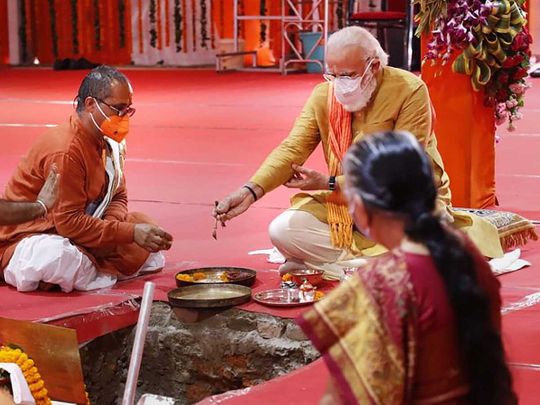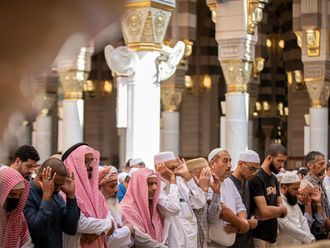
Narendra Modi, Prime Minister of India, is very conscious of his saffron legacy - the historic bhoomi pujan of the Ram Mandir in Ayodhya considered to be the birthplace of Ram - has put him in the pantheon of the saffron greats.
The grand, minutely choreographed solemn function saw Modi draw an analogy of the “karsevaks” (those who carried out the Janambhoomi agitation) with those who fought for India’s independence.
This should settle the debate about what exactly the Ram Mandir meant to the votaries of Hindutva. The time 12.44pm (Rahu Kalam) and the day August 5 had special meaning. On this day, exactly a year ago, Modi had stripped the state of Jammu and Kashmir of its special status (Article 370) and broken it down (first ever in the union) to two union territories of Kashmir and Jammu and Ladakh.
August 5 will go down as a saffron red letter day for the Sangh since these two projects were central to the Hindutva project in India. The only thing remaining on the Sangh wishlist is a uniform civil code, which will be ticked off the to-do list by the end of the year. A listless and out of ideas Opposition these days does “saffron me too”.
Modi did a “dandvat Pranam” (full body prostration) before the idol of Ram Lalla (baby Ram). The prostration was also an acknowledgement of his ideological mentor -- the RSS whose “pracharak” (full time worker) he once was. Now the Sangh lavishly endorses he is the biggest star in the saffron firmament much above Atal Behari Vajpayee, who was the first BJP prime minister of India.
The choice of who shared the stage with Modi on this historic occasion had extreme significance - the biggest Hindutva votary Mohan Bhagwat, RSS chief, and Yogi Adityanath, the monk turned chief minister of India’s politically most important state Uttar Pradesh (which sends 80 MP’s to the Lok Sabha).
The heavyweight hindutva line up also revealed the kal, aaj aur kal of the Sangh. The conflation of Modi and Yogi sent out an unambiguous signal that Yogi was the Sangh succession plan for Modi, his designated heir. After all who could be more saffron than Yogi?
Read more from Swati Chaturvedi
- Sushant Singh Rajput death: A political circus plays out for a fistful of votes in the Bihar elections
- India’s National Education Policy: Anti-English is anti-poor as it robs them of a future
- Another virus plagues India: Modi’s economic advisers are cheerleaders not managers
- Sushant Singh Rajput met book publisher thrice: What did he want to write about?
The trifecta of the three on stage with Bhagwat sharing the foreground shows how far the Sangh has come in its decades’ long civilisational battle for its vision of India as a Hindu nation. The oppositional response, instead of fighting for the secular Indian Constitution, is to try and be a ‘me too’ paler shade of saffron.
The Sangh has always had clarity about its project of a “Hindu Pradhan desh” (Hindu first country). From thrice banned (once in British times) the Sangh has come full circle occupying every institution of note. From the Big House (Rasthrapati Bhavan) atop Raisina hill to a full majority government which showcases the Sangh with pride.
Forgotten yesteryear was the original “Hindu Hriday Samrat” (king of Hindu hearts) L.K. Advani, the founder of the BJP, who took out a Rath Yatra in 1992, which cut a swathe of blood across India. Advani and Murli Manohar Joshi are both under trials in the criminal case to destroy the Babri Masjid.
History has moved on leaving them behind.









